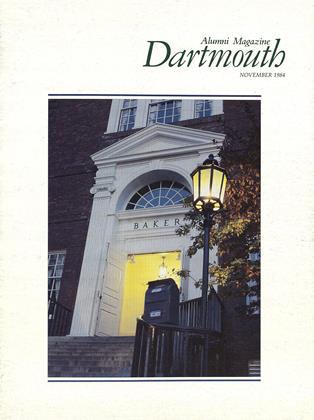"Scholarship is sometimes as dependent on luck in the field as on hours of research in a library," began a 1979 Alumni Magazine article about Dartmouth geographer Vincent Malmstrom's research. Serendipity has again played a part in Malmstrom's latest findings, which hinged on a chance meeting in an airport.
Malmstrom has identified what he believes is the oldest lunar observatory in the Western Hemisphere. He told archeologists at a scientific conference in Mexico City inflate September that an observatory in the ancient Mayan city of Edzna may date from the first century A.D. It was establishing the date when Edzna was founded which caused Malmstrom problems in formulating his conclusions. And the problem was later solved when Malmstrom happened to meet, at an airport, a stranded American archeologist who held the key to his research.
Malmstrom feels Edzna was likely the birthplace of a major modification of the Mayan calendar which took place soon after the birth of Christ. Beginning in 1976, the year he came to Dartmouth, Malmstrom undertook an extensive examination of the Mayan calendar with the help of the College's computers. He found that the Mayans had apparently reformed their calendar in the first cen tury A.D., and in doing so they had moved their New Year's Day from August 13 to July 26. Examining maps of Central America, Malmstrom calculated that the sun is at its zenith on July 26 at Edzna, a Mayan site previously thought to be of little archeological importance and, by Mayan standards, of fairly late construction.
In 1978, Malmstrom led a group of Dartmouth students on a foreign study trip to Edzna, located on the Yucatan Peninsula. Malmstrom himself had previously visited Edzna in 1974 when he was on the faculty at Middlebury College. Examining the ruins on the 1978 trip, Malmstrom became convinced that the place was a site of great astronomical importance. It was, he believed, not only the site of the Mayan calendar reform, but also of the Western Hemisphere's first lunar observatory. There was a major problem with his hypotheses, however. Edzna was generally believed to have been built about the seventh century A.D., some 600 years after the calendar change he had postulated.
Enter the hand of chance. On a subsequent trip to examine Mayan ruins in Mexico, Malmstrom happened to run into an archeologist from Brigham Young University who was stranded at the airport because of engine trouble. The Brigham Young professor, Ray Matheny, proved to be familiar with the ruins at Edzna. In fact, he had discovered through aerial observations a vast system of canals at Edzna that marked the place as a Mayan city of great importance. Malmstrom told Matheny of his problem with the generally-accepted date of Edzna's origins. To his surprise, Matheny responded by noting that his own excavations had revealed that Edzna had been founded in the second century B.C.
Malmstrom was revealing his findings for the first time at the Mexico City conference, which was arranged to share knowledge of Mayan and Aztec astronomy in ancient times as an inaugural for the University of Mexico's Institute for Anthropological Research.
 View Full Issue
View Full Issue
More From This Issue
-
 Feature
FeatureThe Draft: To Register or Not to Register
November 1984 By James Heffernan -
 Feature
FeatureLife After the Presidency
November 1984 By Shelby Grantham -
 Feature
FeatureHamming It Up
November 1984 By Gay E. Milius, Jr. '33 and Dick Dorrance '36 -
 Feature
FeatureGet a Job
November 1984 By Nancy Wasserman '77 -
 Feature
FeaturePractice, practice, practice
November 1984 -
 Books
BooksSo Much More
November 1984 By Peter Smith
Article
-
 Article
ArticleDARTMOUTH IN THE NEW HAMPSHIRE GOVERNMENT
March, 1923 -
 Article
ArticleAlumni Dinners
MARCH 1930 -
 Article
ArticleDodge Stars at Middlebury
April 1951 By Cliff Jordan '45 -
 Article
ArticleHanover Browsing
October 1939 By HERBERT F. WEST '22 -
 Article
ArticleDartmouth in Mew York
October 1937 By Milburn McCarty Jr. '35 -
 Article
ArticleTHOMAS W. D. WORTHEN
DECEMBER 1927 By One of His Sons


